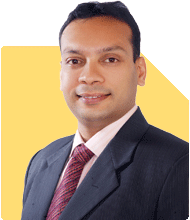Need Expert Advice?Our Gurus Can Help
Patrick Dsouza |1434 Answers |Ask -Follow
CAT, XAT, CMAT, CET Expert - Answered on Dec 30, 2025

Ravi Mittal | Answer |Ask -Follow
Dating, Relationships Expert - Answered on Dec 29, 2025
.jpg)
I understand how you must be feeling. I suggest you try starting with a HI and introducing yourself. Chances are she doesn’t even know you at all; a simple hi and simple would at least solve that. Try being friends first and see how she is treating you and how she is up front. We do tend to idolize our crushes only to find out that they were never our type. Please try friendship first and if things seem to go your way, let her know how you feel. If she doesn’t reciprocate your feelings, respect her opinion and give her space. But right now if you go and profess your love, she will 100% shoot it down because you are just a stranger.
Hope this helps
Samraat Jadhav |2525 Answers |Ask -Follow
Stock Market Expert - Answered on Dec 29, 2025
Krishna Kumar |398 Answers |Ask -Follow
Workplace Expert - Answered on Dec 28, 2025

Answer is yes and no.
Yes, because it has an impact on age difference between you and your peers.
No, because you had a genuine reason.
My suggestion would be vo ahead with B.Tech and then address the issue as it comes.
Nayagam P P | Answer |Ask -Follow
Career Counsellor - Answered on Dec 28, 2025

RediffGURUS ko follow karo 'Careers | Money | Health | Relationships' par aur bhi jaankari pane ke liye."
Nayagam P P | Answer |Ask -Follow
Career Counsellor - Answered on Dec 28, 2025

Diploma in Hospitality & Tourism Management (1 Year): This course directly aligns with your brother's travel coordinator background, covering hotel operations, customer service excellence, and tourism management fundamentals. Institutions offer ?95,500–?1 lakh fees with 100% placement claims into five-star hotels and international brands. Core subjects include hospitality sales, marketing, public relations, business communication, and tourism geography. Graduates secure roles as hotel managers, guest service coordinators, event managers, and travel executives earning ?2–5 LPA. The 20–25 weeks industrial training component provides hands-on experience in operational departments. Given his decade-plus travel sector background, he already possesses customer service competencies, making this transition seamless while adding formal credentials that unlock management-track positions previously unavailable as a 10th-pass coordinator.
Diploma in Hotel Management (1 Year): Focused specifically on front-office operations, food-beverage management, and guest experience, this diploma equips professionals to transition into supervisory and management roles within hospitality chains. Eligibility is 10th/12th pass with 40–50% marks; duration is one year with hands-on laboratory modules. Key subjects cover front-desk operations, reservation systems, housekeeping coordination, and event management fundamentals. Graduates work as front-office managers, housekeeping supervisors, and guest service leads earning ?2–4 LPA initially, progressing to ?5–8 LPA within 3–5 years. The practical training embedded in the curriculum ensures real-world readiness, and hospitality chains aggressively recruit diploma graduates for entry-to-mid-level supervisory positions, offering faster promotion pathways than starting as an entry-level employee without formal credentials.
Diploma in Aviation & Travel Management (3 Years): This specialized diploma deepens expertise in ground-handling operations, passenger services, and tour logistics—critical for evolving from a travel coordinator to a travel manager or aviation ground-handling officer. Subjects include aviation operations, tour planning, tourism bodies and regulations, passenger handling, and tour-guide training. Career opportunities include cabin-crew assistant, ticketing officer, ground-handling officer, tour operator, and travel executive positions within airlines, cruise lines, and international tour operators. While the 3-year duration is longer than alternatives, it opens doors to aviation and premium hospitality sectors with higher salary progression (?2.5–7 LPA after 3 years). Your brother's coordinative background provides a strong foundation; this qualification signals commitment to mid-to-senior roles in tourism and aviation, sectors where demand outpaces supply, especially for professionals with prior industry experience.
Diploma in Computer Applications (DCA) – 6 Months to 1 Year: For rapid re-employment, a short-duration DCA course covering MS Office, basic programming, and database management is ideal. This 6–12 month certification costs ?15,000–?40,000 and qualifies professionals for office administration, data-entry, and customer-service roles across hotels, travel agencies, and corporate offices. DCA is universally recognized, improving employability for roles requiring computer proficiency—increasingly essential in modern travel firms using booking software like GDS (Global Distribution Systems). Salary range: ?1.5–3 LPA entry-level, rising quickly with experience. This is an excellent complementary credential alongside hospitality diplomas or as a standalone quick-win for immediate employment while pursuing longer-term hospitality qualifications.
Certificate in Soft Skills & Office Management (3–6 Months): Designed for mid-career professionals, this short-term certificate covers communication, personality development, MS Office, and professional etiquette—skills often lacking in 10th-pass candidates but crucial for supervisory transitions. Cost: ?8,000–?20,000; duration: 3–6 months; offered by government institutes (NSTI) and private training centers. Content includes spoken English, interview techniques, email writing, and workplace soft skills, directly addressing gaps identified during job interviews. Graduates quickly move into office-executive, sales-coordinator, and administrative-assistant roles across hospitality, travel, and corporate sectors earning ?1.2–2.5 LPA. This is an ideal foundation course for your brother before or paralleling a longer hospitality diploma, providing immediate job-readiness while building confidence for higher-level certifications and interviews. To successfully transition into a new career, your brother must execute a strategic, multi-phase job-landing plan encompassing education, networking, skill documentation, and consistent interview preparation.
Step 1 - Clarify Career Direction & Role: Define whether your brother wants to advance in travel/tourism (travel manager, tour operator) or transition into hospitality operations (hotel manager, guest-services head). Research salary ranges, working hours, and growth potential for each pathway using job portals (LinkedIn, Indeed, Naukri). Clarifying this prevents wasted effort on misaligned courses and helps customize resume and interview narratives accordingly, increasing placement success by 40%.
Step 2 - Enroll in a Focused Diploma: Based on career direction, immediately enroll in a one-year Diploma in Hospitality & Tourism Management or Hotel Management—courses directly relevant to his background. Prioritize IIHM-affiliated, IGNOU-recognized, or government polytechnic institutes to ensure credential credibility recognized by major hotel chains and tour operators. While studying, network with instructors and classmates from industry; many institutes facilitate direct placements through partnerships with Taj, ITC, and international chains.
Step 3 - Build a Compelling Career-Change Narrative: Craft a concise story addressing his layoff professionally: "After 15+ years in travel coordination, I faced restructuring. Rather than seeking similar roles, I'm upskilling formally to transition into hotel/tour management where my customer-service expertise and industry knowledge provide unique value." Practice this narrative for interviews; employers value honesty and proactive reskilling over defensive explanations, improving interview success by 35%.
Step 4 - Leverage Transferable Skills: Document skills from his travel-coordinator role: customer communication, itinerary planning, vendor coordination, problem-solving under pressure, and budget management. On resumes and LinkedIn, explicitly link these to hospitality needs (e.g., "vendor coordination" → "supplier management for F&B," "itinerary planning" → "event logistics"). Recruiters hire for attitude and foundational competencies; his maturity and hands-on experience differentiate him from younger diploma graduates.
Step 5 - Optimize LinkedIn & Digital Presence: Update LinkedIn profile with new career direction, completed coursework, and certifications within 48 hours of enrollment. Write a compelling headline: "Hospitality Professional | Travel Coordinator Transitioning to Hotel Management | IIHM Diploma Student." Connect with recruiters, hotel HR contacts, and 20–30 peers from similar backgrounds. Post weekly about hospitality insights, certification milestones, and industry trends to remain visible to potential employers.
Step 6 - Network Actively Across the Industry: Attend hospitality conferences, hotel expo events, and tourism association meetings (IATO—Indian Association of Tour Operators, ATOAI—Association of Tourism Officers of India). Use existing travel-industry contacts to arrange coffee meetings with hotel HR managers; ask for industry insights, not directly for jobs. Research shows 31% of placements occur via networking; your brother's existing contacts are goldmines for introductions.
Step 7 - Internship/Apprenticeship During Study: Secure a paid or unpaid internship (minimum 3–6 months) in a hotel front office or tour operator during or immediately after diploma completion. This provides resume credentials ("Intern, Le Meridien Front Office, 6 months") and industry connections. Many institutes mandate internships; ensure placement in reputable chains (Taj, Marriott, ITC, SOTC Travel) for maximum credibility and potential job offers post-internship.
Step 8 - Create a Portfolio & Achievement Documentation: Compile a professional document showcasing diploma certificates, internship completion letters, training course completion, and any hospitality-related projects undertaken during studies. Include 2–3 customer testimonials from previous travel-coordination work ("Highly organized professional, excellent communication"). This portfolio differentiates older career-changers from entry-level candidates; present it during interviews to demonstrate commitment and practical competence.
Step 9 - Tailor Resume & Cover Letter per Role: For each job application, customize resume to highlight role-specific keywords (e.g., "guest-service excellence," "reservation-system management," "event coordination"). Write 1-paragraph cover letters addressing why your brother chose this specific organization and role; avoid generic templates. Research hiring manager's name via LinkedIn; personalized outreach increases response rates by 50%. Apply to 8–12 positions weekly on Naukri, Indeed, and LinkedIn Jobs.
Step 10 - Prepare & Practice Interview Skills: Anticipate common questions: "Why this career change?", "Why at 46?", "Your weaknesses?", "Salary expectations?" Practice answers with a mentor or career coach (?2,000–5,000/session via Bharat Skill, Udemy, or LinkedIn Learning). Record video-practice interviews to refine body language and tone. Mock-interview at least 5–10 times before actual interviews. This preparation increases interview-to-offer conversion by 45%, critical for competing against younger candidates.
Summary & Expected Timeline: Within the first two weeks, your brother should clarify his career direction, enroll in a suitable diploma program, and optimize his LinkedIn profile, targeting 50+ connections. During months 1–12, he completes the diploma coursework, secures a 3-month internship, and attends 2–3 industry events, achieving a diploma certificate, internship letter, and 200+ LinkedIn followers. From month 13 onwards, he actively tailors resumes, conducts intensive interview practice, and applies to 8–12 positions weekly, targeting 2–4 interviews per week with realistic expectations of a first job offer within 30–60 days. The overall timeline spans 14–18 months from enrollment to employment. The expected outcome is that your brother transitions from an unemployed travel coordinator to a hotel front-office manager, tour operator, or guest-services supervisor earning ?2–3.5 LPA, with clear career pathways to ?5–7 LPA within 3–5 years. His prior industry experience combined with formal credentials provides a competitive advantage over younger diploma graduates without practical background; this combination positions him for both immediate placement and sustained career growth in the hospitality and tourism sectors. All the BEST for Your Brother's Prosperous Future!
Follow RediffGURUS to Know More on 'Careers | Money | Health | Relationships'.
Nayagam P P | Answer |Ask -Follow
Career Counsellor - Answered on Dec 28, 2025

Follow RediffGURUS to Know More on 'Careers | Money | Health | Relationships'.
Anu Krishna |1759 Answers |Ask -Follow
Relationships Expert, Mind Coach - Answered on Dec 28, 2025

I am not going to lecture you on how to use social media, you know that already!
But what and how much is a choice that you need to think about...Why are you so interested in sharing personal details there? Unless you are a travel vlogger, who exactly is interested in where you travel to? And why should anyone be curious to know hoe you spent time with your friends?
I think this could be a good place for you to start reflecting; if the 'likes', 'comments' are giving you a good kick to your self-esteem, actually time to see how this can happen in a more better and safer way. Safer, because there are a lot of 'creeps' out there noticing and noting each post of yours...Be safe; and of course, it may seem funny to have your parents and Professors on your list BUT blocking them will only mean that you are avoiding what they feel about your safety on social media.
Be safe and Be wise about this...
All the best!
Anu Krishna
Mind Coach|NLP Trainer|Author
Drop in: www.unfear.io
Reach me: Facebook: anukrish07/ AND LinkedIn: anukrishna-joyofserving/
Anu Krishna |1759 Answers |Ask -Follow
Relationships Expert, Mind Coach - Answered on Dec 28, 2025

Your grades are the ones doing all the talking here; keep them at a better level and why would your parents bother if you clock in the mandated hours for attendance.
You can't have the cake and eat it too, yeah? Focus, study and have fun as well...
All the best!
Anu Krishna
Mind Coach|NLP Trainer|Author
Drop in: www.unfear.io
Reach me: Facebook: anukrish07/ AND LinkedIn: anukrishna-joyofserving/
Dr Dipankar Dutta |1843 Answers |Ask -Follow
Tech Careers and Skill Development Expert - Answered on Dec 27, 2025
Dr Upneet Kaur |74 Answers |Ask -Follow
Marriage counsellor - Answered on Dec 27, 2025

Mam, its tuf to manage long distance relationships as the communication is always a matter of concern. They can be managed by a good communication which you are telling me is very less.
Sometimes the things or factors that hamper communication are different time zones, working hours, place of living weather they are sharing apartment with someone or not. So all these factors should be taken into consideration.
If you feel that all these factors are manageable in this case and only the factor is that the person is not interested in talking, then it could be a matter of concern. If you feel like that he is being an avoidant partner then talk about this to your parents and tell them your opinion honestly.
Then you need to think about this relationship.
I hope this solves your problem.
Take care
Follow me: https://www.instagram.com/dr_upneet
Mayank Chandel |2586 Answers |Ask -Follow
IIT-JEE, NEET-UG, SAT, CLAT, CA, CS Exam Expert - Answered on Dec 27, 2025
Mayank Chandel |2586 Answers |Ask -Follow
IIT-JEE, NEET-UG, SAT, CLAT, CA, CS Exam Expert - Answered on Dec 27, 2025
Mayank Chandel |2586 Answers |Ask -Follow
IIT-JEE, NEET-UG, SAT, CLAT, CA, CS Exam Expert - Answered on Dec 27, 2025

Dr Nagarajan J S K |2585 Answers |Ask -Follow
NEET, Medical, Pharmacy Careers - Answered on Dec 27, 2025

By reviewing your query, you have now realized the importance of your career. Does your state government accept a second attempt in basic education for competitive exams? If so, you can proceed.
BEST WISHES.
SERIOUS SINCERE SYSTAMATIC SERVICE SECURE SUPREME SUCCESS.
CAREER REDIFFGURU.
Dr Nagarajan J S K |2585 Answers |Ask -Follow
NEET, Medical, Pharmacy Careers - Answered on Dec 27, 2025

Why do you want to enroll in NIOS?
What are your future plans?
What are your marks in 11th grade?
Without answers to the above questions, I am unable to share my views.
So kindly share.
SERIOUS SINCERE SYSTAMATIC SERVICE SECURE SUPREME SUCCESS.
BEST WISHES.
CAREER REDIFFGURU.
Dr Nagarajan J S K |2585 Answers |Ask -Follow
NEET, Medical, Pharmacy Careers - Answered on Dec 27, 2025

The query may seem straightforward, but achieving a low score in postgraduate (PG) exams is often inadequate. In reality, this strategy may lead you to less competitive courses that tend to be more academically focused. Most PG aspirants seek clinically oriented programs such as Radiology, Surgery, and Medicine, rather than non-clinical areas like Anatomy, Physiology, Biochemistry (which is indeed a significant field but is often overlooked during undergraduate studies), and Pharmacology (which is also industry-oriented).
Ultimately, your success will depend on the specific courses you are interested in. It is important to note that a score of 29,000 is generally not sufficient to secure admission into a clinical course. So Hope for the best.
I hope this clarifies your question.
SERIOUS SINCERE SYSTAMATIC SERVICE SECURE SUPREME SUCCESS.
BEST WISHES.
CAREER REDIFFGURU
Dr Nagarajan J S K |2585 Answers |Ask -Follow
NEET, Medical, Pharmacy Careers - Answered on Dec 27, 2025

The scope for Biomedical Engineering (BME) in India is quite limited because this field is primarily service-oriented. For example, in corporate hospitals, highly sophisticated instruments such as CT, MRI, and X-ray machines can be operated by BME professionals. If BME graduates are well-skilled, they have the potential to fabricate simple medical devices that can benefit society. Ultimately, it depends on the aspirations of the graduates—whether they aim to become entrepreneurs or want to acquire technical skills.
In addition to fabrication, BME professionals can also focus on servicing, calibration, and validation procedures, and can gain expertise in these areas.
NEW JOB OPPORTUNITY IN INDIA: Our government has made it possible for engineers to become eligible to audit medical devices, similar to drug inspectors in the Drug Department. To become a device inspector, candidates must pass an exam conducted by the relevant authorities.
It's important to note that just having an education is not sufficient; it only serves as the eligibility criterion. Graduates must also acquire practical skills to become competent in the job market.
That summarizes the scope of Biomedical Engineering.
SERIOUS SINCERE SERVICE SECURE SUPREME SUCCESS.
BEST WISHES.
CAREER REDIFFGURU
Radheshyam Zanwar |6758 Answers |Ask -Follow
MHT-CET, IIT-JEE, NEET-UG Expert - Answered on Dec 27, 2025

Good luck.
Follow me if you receive this reply.
Radheshyam
Radheshyam Zanwar |6758 Answers |Ask -Follow
MHT-CET, IIT-JEE, NEET-UG Expert - Answered on Dec 26, 2025

Most Imp: No doubt, Class 10 is an important milestone, but a child’s career does not end with its results. Often, excessive pressure in Class 10 drains students mentally and emotionally, and they struggle later in Class 12 while preparing for engineering or medical entrance exams. What truly matters is whether your child is studying regularly and consistently. Please avoid judging your child only by marks or percentiles; sustained effort, balance, and well-being are far more important for long-term success.
Best of luck to your daughter for her bright future.
Good luck.
Follow me if you receive this reply.
Radheshyam
Reetika Sharma |463 Answers |Ask -Follow
Financial Planner, MF and Insurance Expert - Answered on Dec 26, 2025

It is great that you are thinking to start investing for your spouse. The funds chosen are good for long term. And if your time horizon for investment is more than 10 years, you can consider the mentioned categories.
However, mutual fund selection also depends on other factors such as goal, risk appetite and many more. So share these details for me to guide you in a better way.
And since you are starting now, avoid following random online tips and take a professional suggestion in this regard.
Or you can connect with a professional Certified Financial Planner - a CFP who can guide you with exact funds to invest in keeping in mind your age, requirements, financial goals and risk profile. A CFP periodically reviews your portfolio and suggest any amendments to be made, if required.
Let me know if you need more help.
Best Regards,
Reetika Sharma, Certified Financial Planner
https://www.instagram.com/cfpreetika/
Ramalingam Kalirajan |10934 Answers |Ask -Follow
Mutual Funds, Financial Planning Expert - Answered on Dec 26, 2025

You have built assets early in life.
You are thinking ahead with responsibility.
Your care for your children is clear.
Planning early gives strong advantage.
» Family and Responsibility Context
You are 36 years old today.
You have two young children.
One child needs lifelong support.
This needs special planning focus.
Your retirement goal is early.
Ten years is a short window.
Still, your asset base is strong.
Correct structure can multiply outcomes.
» Income and Expense Understanding
Your monthly income is about Rs 1.5 lakh.
Your expenses are about Rs 1 lakh monthly.
General expenses are Rs 60,000 monthly.
Therapy expenses are Rs 40,000 monthly.
This expense is essential and non negotiable.
It must be planned lifelong.
Your surplus today is limited.
But your existing assets are powerful.
» Current Asset Summary Review
You have strong diversification already.
That deserves appreciation.
You hold PPF worth around Rs 50 lakh.
This includes accounts for both spouses.
You hold mutual funds worth Rs 22 lakh.
You invest around Rs 24,000 monthly.
You hold shares worth around Rs 12 lakh.
You hold gold bars worth around Rs 60 lakh.
You hold silver bars worth around Rs 20 lakh.
You hold idle savings of around Rs 70 lakh.
This shows strong accumulation ability.
But allocation balance needs correction.
» Early Retirement Reality Check
Retiring at 46 is ambitious.
It is not impossible.
However, responsibilities are high.
Healthcare and child support extend long.
Early retirement needs higher corpus.
Income replacement period becomes long.
Planning must be conservative and flexible.
» Core Retirement Planning Principle
Retirement planning means income continuity.
Corpus size alone is not enough.
Cash flow sustainability matters most.
Inflation protection is critical.
Capital safety gains importance later.
Growth is still required now.
» Special Child Long Term Planning
Your special child needs lifelong support.
This is the most important factor.
Planning must assume longer dependency.
Care costs may rise over time.
Inflation impacts therapy and care sharply.
Medical costs grow faster than normal inflation.
Separate planning bucket is required.
This ensures peace of mind.
» Emergency and Contingency Planning
Emergency fund is critical for your case.
At least one year expenses should be liquid.
Therapy disruption must be avoided.
Cash buffer prevents forced selling.
Your savings account amount helps here.
But it should be structured better.
» Idle Savings Account Risk
Keeping Rs 70 lakh idle is risky.
Inflation eats value silently.
Savings interest rarely beats inflation.
Purchasing power reduces yearly.
Idle money must work harder.
This is your biggest opportunity area.
» Gold and Silver Allocation Assessment
Gold exposure is very high.
Silver exposure is also high.
Precious metals protect against uncertainty.
They do not generate income.
They underperform productive assets long term.
Price cycles can stay flat for years.
Liquidity during emergencies can be tricky.
Tax efficiency is also limited.
Holding some gold is sensible.
Excessive holding limits growth.
Gradual rebalancing is advisable.
No emotional selling is required.
» Equity Role in Early Retirement
Equity is essential for your goal.
Ten years still needs growth assets.
Inflation protection requires equity exposure.
Debt alone will not suffice.
Actively managed equity funds suit better.
They adjust during market cycles.
They manage valuations and risks actively.
Index based investing has limitations.
Index funds buy expensive stocks blindly.
They fall fully during corrections.
Active managers can reduce exposure early.
This protects capital during stress.
» Mutual Fund SIP Evaluation
Your SIP amount is modest.
Considering goals, it should increase.
However, expenses limit monthly surplus.
Lumpsum investing may work better.
Redirect idle savings gradually.
Avoid market timing fear.
Phased deployment reduces volatility risk.
» Direct Equity Holding Review
Direct shares require time and expertise.
They add concentration risk.
Monitoring becomes difficult long term.
Behavioural mistakes are common.
Gradual shift towards managed funds helps.
This reduces personal monitoring burden.
This is not immediate advice.
It can be planned slowly.
» Regular Plans and Professional Support
Regular mutual fund plans provide guidance.
Behaviour support is valuable near retirement.
Direct plans save cost only.
They lack emotional control support.
Wrong decisions erase saved costs quickly.
Discipline matters more than expenses.
Regular plans via MFD with CFP credential add value.
They help during corrections and rebalancing.
» Asset Allocation Re Structuring Need
Your current allocation is skewed.
Gold and cash dominate assets.
Growth assets need higher share.
This supports early retirement goal.
Rebalancing should be gradual.
Tax impact must be considered.
Avoid sudden large shifts.
» Phased Strategy for Idle Cash
Idle savings should not remain idle.
Phased investment works best.
Divide amount into multiple tranches.
Deploy across time.
This reduces timing risk.
It builds discipline.
This can significantly boost corpus.
» PPF Role in Your Portfolio
PPF provides stability and tax efficiency.
It suits conservative allocation.
However, returns are moderate.
Liquidity is restricted.
PPF alone cannot fund early retirement.
It should complement equity.
Continue PPF discipline.
Avoid over reliance.
» Retirement Corpus Sustainability
Early retirement needs longer income period.
Corpus must last decades.
Withdrawal planning is critical.
Random withdrawals damage sustainability.
Cash buffer helps during market falls.
Equity should not be sold in panic.
Planning withdrawals early matters.
» Healthcare and Insurance Planning
Health insurance coverage must be strong.
Family floater may be insufficient.
Special child may need dedicated planning.
Policy terms must be reviewed carefully.
Insurance reduces financial shock.
But does not cover everything.
Separate healthcare reserve is wise.
» Lifestyle Planning Post Retirement
Retirement is not only money.
Daily structure matters.
Active lifestyle reduces health costs.
Purpose reduces mental stress.
Financial security supports dignity.
» Education and Child Support Planning
Your younger child education needs planning.
Costs will rise with inflation.
Special child planning needs higher buffer.
Support may extend lifelong.
This must be separate from retirement.
» Estate and Legal Planning Importance
Nomination must be updated everywhere.
This avoids legal hassles.
Special child requires clear guardianship planning.
Trust structures may be explored.
This ensures lifelong care continuity.
» Tax Awareness and Discipline
Tax efficiency improves net outcomes.
Unplanned exits increase tax burden.
Equity gains have specific rules.
Long term planning reduces tax leakage.
Avoid frequent churn.
Let compounding work.
» Review Frequency and Behaviour Control
Annual review is sufficient.
Avoid daily market tracking.
Volatility is normal.
Patience creates wealth.
Stick to strategy during stress.
» Psychological Strength and Confidence
You are doing many things right.
Your concern shows responsibility.
Small corrections can create big impact.
Time is still on your side.
Early action multiplies results.
» Finally
Your base is strong.
Your intent is clear.
Focused rebalancing can boost outcomes.
Gradual shifts protect peace of mind.
Early retirement is possible with discipline.
Planning must prioritise family security.
Consistency and structure will reward you.
Best Regards,
K. Ramalingam, MBA, CFP,
Chief Financial Planner,
www.holisticinvestment.in
https://www.youtube.com/@HolisticInvestment
Ravi Mittal | Answer |Ask -Follow
Dating, Relationships Expert - Answered on Dec 26, 2025

I am sorry you are in such a tricky situation. In such cases, you need to make a choice. I know that your partner has a lot on his plate in terms of making a career, but should you be on his list of priorities too? “In sab ke ilawa kuch nahi sujhta,” sounds a bit too indifferent. But then again, you know him better than anyone else. I believe you two need to have a serious talk. Let him know that you can wait about N number of years for him, but if he can’t commit by then, you need to rethink the relationship. This is not an ultimatum but rather you would be laying down a clear picture of the reality of the situation. Both him and you should have clarity and be on the same page, and for that, having an honest discussion is very important. Start with that and see where it goes.
Hope this helps.
Ramalingam Kalirajan |10934 Answers |Ask -Follow
Mutual Funds, Financial Planning Expert - Answered on Dec 26, 2025

Reaching this stage with clarity gives you real advantage.
Retirement planning at 52 is still very workable.
Timely action can create lasting comfort and dignity.
» Current Financial Snapshot Understanding
You earn around Rs 2.5 lac monthly.
Your regular expenses are about Rs 70,000.
This leaves healthy surplus every month.
High surplus gives flexibility and control.
Many people miss this advantage.
You have scope for fast correction if required.
Your age suggests retirement is approaching.
Time horizon may be around eight to ten years.
This period is short but still powerful.
» Retirement Vision Clarification
Retirement planning starts with lifestyle clarity.
You must visualise your retired life.
Think about:
– Monthly expenses after retirement
– Healthcare needs with age
– Travel or leisure goals
– Support for family members
– Emergency requirements
Expenses may reduce in some areas.
Healthcare costs may rise steadily.
Inflation will impact daily living costs.
Planning must consider these realities calmly.
» Understanding Retirement Income Needs
Post retirement income must replace salary partially.
Not all current expenses continue.
Some costs disappear after work life.
However, medical and comfort costs rise.
Longevity risk must be planned carefully.
Income should be stable and predictable.
Capital protection becomes important gradually.
Your plan should aim steady income flow.
Growth should still continue for inflation control.
» Time Horizon and Risk Balance
At 52, risk capacity is moderate.
Risk tolerance may differ personally.
Equity exposure is still required.
It supports growth against inflation.
Excessive risk can cause stress.
Very low risk reduces future income power.
Balance is essential now.
Gradual shift towards stability is sensible.
» Savings Potential Assessment
Your monthly surplus is significant.
This is your biggest strength.
Regular investments can build large corpus.
Consistency matters more than timing.
Lumpsum investing can accelerate growth.
This works well during market corrections.
You must structure surplus smartly.
» Asset Allocation Thought Process
Retirement planning needs asset balance.
No single asset should dominate.
Equity supports growth.
Debt provides stability.
Cash ensures liquidity.
Allocation should change with age.
Risk should reduce gradually.
Avoid emotional asset shifts.
Follow disciplined rebalancing approach.
» Role of Actively Managed Mutual Funds
Actively managed funds adjust with market cycles.
They avoid overpriced sectors early.
Managers focus on valuations and quality.
They protect downside during corrections.
Indian markets reward active strategies.
Inefficiencies still exist here.
This helps long term investors.
Index strategies blindly follow markets.
They buy expensive stocks automatically.
They fall fully during corrections.
No human judgment exists.
Actively managed funds suit retirement goals better.
» Regular Plans Versus Direct Plans
Regular plans provide ongoing professional support.
Behaviour management is crucial near retirement.
Direct plans lack guidance.
Wrong decisions can destroy wealth quickly.
Cost saving looks attractive initially.
Mistakes cost much more later.
Regular plans through MFD with CFP credential add value.
They help during volatility and rebalancing.
Staying disciplined matters more than expense ratio.
» Emergency and Contingency Planning
Emergency funds must be kept separate.
Retirement corpus should never fund emergencies.
Medical emergencies are unpredictable.
Cash buffers reduce stress.
Insurance review is critical.
Adequate health cover is essential.
Term insurance may still be needed.
This depends on family responsibilities.
» Healthcare Planning Importance
Healthcare costs rise faster than inflation.
Age increases medical dependency.
Insurance alone may not suffice.
Out of pocket costs still exist.
Dedicated healthcare reserve helps.
This protects retirement income flow.
Do not ignore this aspect.
» Pre Retirement Debt Review
Aim to be debt free before retirement.
Loans increase pressure on fixed income.
Clear high interest liabilities first.
This improves mental peace.
Avoid new large loans now.
Focus on stability phase.
» Tax Efficiency in Retirement Planning
Tax planning supports higher net income.
Wrong withdrawals increase tax burden.
Equity mutual fund taxation rules apply.
Long term gains have favourable rates.
Avoid frequent churning.
Tax leakage reduces corpus.
Withdrawal strategy matters deeply.
» Withdrawal Strategy Post Retirement
Retirement income should come systematically.
Random withdrawals harm sustainability.
Withdraw from growth and stability balance.
This controls volatility impact.
Maintain cash buffer for yearly needs.
Avoid selling equity during market falls.
Planning withdrawals is as important as investing.
» Inflation Protection Strategy
Inflation silently reduces purchasing power.
Fixed income alone fails over long periods.
Equity allocation helps fight inflation.
This remains necessary even after retirement.
Gradual reduction works better than sudden exit.
» Lifestyle Planning and Mental Preparation
Retirement is not just financial.
It is emotional and social shift.
Purpose after retirement matters.
Active lifestyle reduces medical expenses.
Financial comfort supports mental peace.
» Estate and Nomination Review
Ensure nominations are updated everywhere.
This avoids family complications.
Simple estate planning helps smooth transfer.
Clarity reduces disputes.
This is often ignored.
» Periodic Review Importance
Plans must be reviewed yearly.
Life changes impact strategy.
Health, income, family needs evolve.
Portfolio must adjust accordingly.
Avoid over monitoring markets.
Stick to plan discipline.
» Finally
You are in a strong position today.
High income and low expenses give power.
Focused planning can still build comfort.
Discipline and structure are key.
Retirement can be peaceful and confident.
Action today secures dignity tomorrow.
Best Regards,
K. Ramalingam, MBA, CFP,
Chief Financial Planner,
www.holisticinvestment.in
https://www.youtube.com/@HolisticInvestment
Ravi Mittal | Answer |Ask -Follow
Dating, Relationships Expert - Answered on Dec 26, 2025

I suggest trying to connect with her emotionally first. You have been away from her for the better part of your married life. It does take a toll on the partner who is left behind to take care of everything back home. I’ll say start small; buy her small but meaningful things when you are coming back from the office; maybe some snacks she likes. Take her for a movie date, or a dinner date; ask someone else to take care of the kids. Plan a vacation together. A lot of problems dissolve naturally when people reconnect emotionally. If it still doesn’t work, I would urge you to have an open conversation and genuinely ask her what is missing in the marriage so that you can work on it. A happy and healthy marriage requires constant effort. I am sure she is worth it.
Hope this helps
Ravi Mittal | Answer |Ask -Follow
Dating, Relationships Expert - Answered on Dec 26, 2025

It is important that you speak to her in person instead of emailing her, especially if she is not responding to your mails. It is possible that she is not interested in you romantically or is confused by your advances and assuming them to be not so harmless. The tone matters and hence, speaking face to face is always a better idea. Let her know that you are attracted to her, but if she does not reciprocate, you need to respect that.
Hope this helps.
Ramalingam Kalirajan |10934 Answers |Ask -Follow
Mutual Funds, Financial Planning Expert - Answered on Dec 26, 2025

Consistency across years shows patience and financial maturity.
You have avoided random chasing of short term trends.
That itself improves long term wealth outcomes.
» Overall Portfolio Structure Assessment
Your portfolio spans multiple equity styles and market segments.
This provides natural risk spreading across cycles.
You hold value oriented exposure.
You also hold growth driven exposure.
Flexi oriented strategies add adaptability during market shifts.
Large segment exposure provides relative stability.
Mid segment exposure adds long term return potential.
Overseas exposure offers currency and geography diversification.
This mix shows thoughtful allocation rather than accidental investing.
The holding period across funds is meaningful.
Most funds crossed initial volatility phases.
This gives useful performance visibility now.
The portfolio does not look cluttered.
However, overlap risk exists between certain categories.
This needs rationalisation, not panic exits.
» Value Oriented Strategy Evaluation
Your value style holding focuses on undervalued businesses.
Such strategies test patience during momentum markets.
Short term underperformance is common here.
Long term cycles often reward value exposure.
Two years is a short assessment window for value strategies.
Value funds need full market cycles to shine.
Exiting now may crystallise temporary underperformance.
Continuation is sensible if volatility tolerance exists.
Gradual review is better than abrupt exit.
Allocation weight should remain moderate.
» Mid Segment Exposure Review
Mid segment investing adds growth fuel to portfolios.
Returns come with higher volatility phases.
Your holding period here is reasonable.
Two to three years is early but acceptable.
Performance often appears uneven year to year.
That behaviour is normal for this segment.
Staying invested improves outcome probability.
However, mid exposure should not dominate total equity.
Risk rises sharply if allocation becomes excessive.
Balancing through flexi strategies helps.
Continuation is advisable with allocation control.
» Flexi Style Holdings Assessment
Flexi strategies allow dynamic market cap movement.
They adjust between large, mid, and selective themes.
This provides stability during corrections.
It also captures upside during recoveries.
Holding more than one flexi strategy may cause overlap.
Overlap increases concentration risk unknowingly.
Performance differences reduce over long periods.
Keeping one strong flexi exposure is sufficient.
The second can be reviewed gradually.
Exit need not be immediate.
Future SIPs can be redirected instead.
This reduces tax impact and emotional stress.
» Large Segment Exposure Evaluation
Large segment strategies add foundation strength.
They smooth volatility during market stress.
Returns may appear modest during rallies.
Risk control remains the core benefit.
Your long holding period here is appropriate.
This acts as portfolio anchor.
Continuation is strongly recommended.
Allocation should align with risk comfort.
It suits investors needing stability with growth.
» Overseas Exposure Review
Overseas equity exposure brings geographic diversification.
It also brings currency movement benefits.
Global leaders add structural growth exposure.
However, this exposure tracks an overseas index.
Index based strategies follow markets blindly.
They cannot avoid expensive stocks.
They cannot reduce exposure during bubbles.
Index strategies suffer during prolonged corrections.
They lack downside protection mechanisms.
Expense ratios remain despite passive nature.
Active global strategies manage risks better.
They rotate sectors and valuations actively.
They control drawdowns more effectively.
Your existing overseas holding should be capped.
Avoid increasing exposure further.
Gradual profit booking can be considered later.
Immediate exit is not mandatory.
» Active Versus Index Strategy Perspective
Index strategies mirror markets without judgement.
They buy expensive stocks automatically.
They sell quality only during index reshuffles.
Active strategies assess valuations continuously.
They avoid overheated sectors early.
They protect capital during downturns.
Long term Indian investors benefit from active management.
Market inefficiencies still exist locally.
Skilled managers exploit these gaps.
Your portfolio largely uses active strategies.
That is a strong positive.
» Regular Plan Holding Evaluation
You hold regular plans consistently.
This supports disciplined investing behaviour.
You receive professional monitoring support.
Portfolio reviews improve decision quality.
Direct plans save costs but lack guidance.
Self decisions often trigger panic exits.
Timing mistakes erode saved expense ratios.
Regular investing through MFD with CFP credential adds value.
Behavioural coaching improves outcomes significantly.
Asset allocation discipline stays intact.
Staying with regular plans is sensible.
» Exit Versus Continue Decision Framework
Exit decisions should follow logic, not emotions.
Ask whether original purpose changed.
Ask whether risk tolerance reduced.
Ask whether allocation became excessive.
Performance alone should not drive exits.
Short term returns mislead often.
Consistency and suitability matter more.
For your portfolio:
– Continue value oriented exposure with patience
– Continue mid exposure within controlled allocation
– Retain one flexi strategy actively
– Review second flexi through SIP redirection
– Continue large segment holding confidently
– Cap overseas index exposure gradually
» Tax Efficiency Considerations
Equity exits within one year attract higher tax.
Exits after one year enjoy lower tax rates.
Avoid unnecessary churn.
Tax leakage reduces compounding power.
Gradual rebalancing is tax efficient.
SIP redirection helps avoid capital gains.
Debt tax rules do not apply here directly.
» Risk Management and Behaviour Control
Market volatility is unavoidable.
Investor behaviour determines outcomes.
Regular reviews prevent emotional reactions.
Rebalancing maintains risk balance.
Avoid frequent fund switching.
Avoid reacting to media noise.
Stay aligned with long term goals.
» Goal Alignment Check
Ensure equity exposure matches goal timelines.
Longer goals suit higher equity allocation.
Near term goals need reduced volatility.
If goals are long term, continue equity SIPs.
If goals are near, reduce risk gradually.
Portfolio suitability depends on goals, not returns.
» Liquidity and Emergency Planning
Equity should not fund emergencies.
Ensure separate liquid reserves exist.
Avoid forced redemptions during corrections.
This preserves compounding benefits.
» Review Frequency Guidance
Annual reviews are sufficient.
Avoid monthly performance tracking.
Markets reward patience.
They punish impatience.
» Finally
Your portfolio shows maturity and balance.
It does not require drastic exits.
It needs fine tuning and monitoring.
Continue most holdings with confidence.
Reduce overlap slowly and logically.
Avoid emotional decisions.
Long term wealth creation stays on track.
Best Regards,
K. Ramalingam, MBA, CFP,
Chief Financial Planner,
www.holisticinvestment.in
https://www.youtube.com/@HolisticInvestment
Patrick Dsouza |1434 Answers |Ask -Follow
CAT, XAT, CMAT, CET Expert - Answered on Dec 25, 2025

Patrick Dsouza |1434 Answers |Ask -Follow
CAT, XAT, CMAT, CET Expert - Answered on Dec 25, 2025

Patrick Dsouza |1434 Answers |Ask -Follow
CAT, XAT, CMAT, CET Expert - Answered on Dec 25, 2025

Dr Nagarajan J S K |2585 Answers |Ask -Follow
NEET, Medical, Pharmacy Careers - Answered on Dec 24, 2025
Purshotam Lal | Answer |Ask -Follow
Financial Planner, MF and Insurance Expert - Answered on Dec 24, 2025

Purshotam, CFP®, MBA, CAIIB, FIII
Certified Financial Planner
Insurance advisor
www.finphoenixinvest.com
Purshotam Lal | Answer |Ask -Follow
Financial Planner, MF and Insurance Expert - Answered on Dec 24, 2025

Purshotam, CFP®, MBA, CAIIB, FIII
Certified Financial Planner
Insurance advisor
www.finphoenixinvest.com
Purshotam Lal | Answer |Ask -Follow
Financial Planner, MF and Insurance Expert - Answered on Dec 24, 2025

Purshotam, CFP®, MBA, CAIIB, FIII
Certified Financial Planner
Insurance advisor
www.finphoenixinvest.com
Kanchan Rai |649 Answers |Ask -Follow
Relationships Expert, Mind Coach - Answered on Dec 24, 2025

What you need first is clarity, not confrontation. When he returns, do not attack him or accuse him. That will only make him defensive or dismissive. Instead, speak from your pain. You might say something like:
“I am not upset only about the trip. I am hurt because I felt alone, lied to, and emotionally abandoned at a time when I needed you. I need honesty and emotional presence to feel safe in this marriage.”
Watch how he responds. Not his words, but his behavior afterward. Does he listen? Does he take responsibility? Does he show concern for your emotional state? Or does he minimize, blame, or tell you to “adjust”?
Also, understand something important: loving him does not mean tolerating emotional neglect. Wanting a peaceful family does not mean silencing your pain. A family becomes peaceful only when both partners feel secure and respected.
If he continues to avoid conversations, lie, or emotionally withdraw, then this is not about Thailand anymore — it becomes about whether he is ready to be a present husband and father. In that case, couple counseling becomes very important, preferably with a neutral professional. If he refuses even that, you will need to start thinking about your own emotional boundaries and long-term wellbeing.
For now, take care of yourself and your baby. Lean on your parents for support. Eat, rest, and breathe. You have already been through loss and childbirth — you are stronger than you think, even if you feel broken right now.
Ramalingam Kalirajan |10934 Answers |Ask -Follow
Mutual Funds, Financial Planning Expert - Answered on Dec 24, 2025

Starting at 43 still offers strong wealth creation time.
Your clarity on goal amount and horizon is positive.
This shows maturity and planning intent.
» Understanding your goal and time horizon
– Your goal amount is Rs.20 lacs.
– Your time horizon is 16 years.
– This is a long-term equity friendly horizon.
– Equity exposure suits this duration well.
– Short-term volatility becomes less important.
– Consistency matters more than timing.
– Your age allows moderate risk acceptance.
– Capital protection is also important.
» Snapshot of your current portfolio structure
– You hold six mutual fund categories.
– Total investment is around Rs.1 lac.
– Allocation is spread across equity styles.
– You also hold a gold-based fund.
– Equity dominates the portfolio structure.
– Debt exposure is currently absent.
– Style overlap exists in some equity segments.
» Broad asset allocation assessment
– Equity exposure is currently very high.
– This suits long horizon goals.
– However balance improves stability.
– Gold adds diversification value.
– Gold should remain limited.
– Debt improves discipline during volatility.
– Emergency buffer should remain outside funds.
» Equity allocation quality review
– You have exposure to flexible equity strategies.
– You have mid and small company exposure.
– You also hold value-oriented equity style.
– This creates growth potential.
– Risk concentration needs attention.
– Multiple aggressive styles increase volatility.
– Style balance improves long-term consistency.
» Small company exposure evaluation
– Small company funds offer high growth.
– They also carry high volatility.
– Returns can be uneven for years.
– Allocation should be controlled.
– Overexposure can hurt discipline.
– One such fund is sufficient.
– Allocation should stay moderate.
» Mid-sized company exposure evaluation
– Mid-sized companies balance growth and stability.
– They suit long-term wealth goals.
– They face periodic drawdowns.
– Allocation should be reasonable.
– One mid-sized fund is adequate.
– Overlapping styles reduce efficiency.
» Flexible equity strategy evaluation
– Flexible equity funds adjust across market caps.
– They reduce timing risks.
– They manage valuations actively.
– This suits your horizon well.
– One such core holding is enough.
– It can anchor the portfolio.
» Value-oriented equity strategy review
– Value style performs well in cycles.
– Returns may lag temporarily.
– Patience is required.
– It improves diversification.
– One value-oriented fund is enough.
» Multi-cap equity strategy review
– Multi-cap funds spread across market sizes.
– They offer internal diversification.
– They reduce dependency on one segment.
– They suit long-term investors.
– One such holding is appropriate.
» Gold allocation review
– Gold protects during equity stress.
– It reduces portfolio volatility.
– It should not drive growth.
– Allocation should remain limited.
– Excess gold reduces equity compounding.
– Retain only a small exposure.
» Missing elements in your portfolio
– Pure debt allocation is missing.
– Debt adds emotional stability.
– Debt supports rebalancing during corrections.
– Debt reduces forced selling risk.
– Some stability-oriented fund is needed.
– This improves long-term discipline.
» Suggested ideal allocation direction
– Equity should remain the majority.
– Growth-oriented equity around two-thirds.
– Stability-oriented assets around one-third.
– Gold should stay small.
– Debt should be meaningful but controlled.
– This mix suits your age.
» Equity internal allocation guidance
– One flexible equity fund as core.
– One multi-cap equity fund for balance.
– One mid-sized company fund for growth.
– One value-oriented fund for diversification.
– One small company fund with low weight.
– Avoid adding more equity styles.
» Funds to consider removing or merging
– Overlapping aggressive equity styles can reduce clarity.
– Two high-risk styles are unnecessary.
– Retain only one small company fund.
– Avoid holding similar mid-growth strategies.
– Simplification improves monitoring.
– Fewer funds increase discipline.
» Should you add any new equity fund
– No need for additional equity styles.
– Existing categories are sufficient.
– Focus should be allocation discipline.
– Adding more funds reduces effectiveness.
» Debt allocation guidance
– Add a low volatility debt-oriented fund.
– This improves portfolio balance.
– It reduces emotional pressure during falls.
– It supports systematic rebalancing.
– Keep expectations modest from debt.
» How to deploy additional investments
– Lumpsum investing should be staggered.
– Market timing risk must be reduced.
– Phased deployment improves comfort.
– Regular contributions improve consistency.
– Avoid deploying everything at once.
» Approximate investment effort required
– Your current amount is insufficient.
– Additional contributions are needed.
– Regular monthly investing helps significantly.
– Small increases create large future impact.
– Lumpsum alone may not suffice.
– Combination approach works best.
» Lumpsum investment perspective
– A meaningful one-time investment helps.
– It accelerates early compounding.
– It reduces future monthly burden.
– It should be invested gradually.
– Avoid emotional reactions during volatility.
» Systematic investment importance
– Regular investing builds discipline.
– It smoothens market volatility impact.
– It improves long-term outcomes.
– It reduces regret risk.
– Consistency matters more than amount.
» Rebalancing strategy importance
– Review portfolio annually.
– Rebalance when allocations drift.
– Book profits from outperforming assets.
– Add to underperforming segments.
– This controls risk automatically.
» Behavioural risk management
– Avoid reacting to market noise.
– Long-term goals need patience.
– Temporary losses are normal.
– Staying invested is crucial.
– Discipline creates wealth.
» Tax awareness for future withdrawals
– Equity gains face capital gains tax.
– Long-term equity gains above threshold are taxed.
– Short-term equity gains carry higher tax.
– Debt gains are taxed at slab rate.
– Holding period matters greatly.
» Liquidity and emergency planning
– Maintain emergency funds separately.
– Do not use equity funds for emergencies.
– This protects long-term investments.
– Peace of mind improves discipline.
» Insurance and protection check
– Ensure adequate term insurance.
– Health insurance should be sufficient.
– Protection supports investment success.
– Avoid mixing insurance and investment.
» Estate and nomination review
– Ensure nominees are updated.
– Maintain clear documentation.
– This avoids future family stress.
– Simple steps create clarity.
» Monitoring and review discipline
– Review portfolio once a year.
– Avoid frequent changes.
– Performance should match category expectations.
– Underperformance over cycles needs review.
» Risks to be mindful about
– Overconfidence during bull markets.
– Panic during market corrections.
– Frequent fund switching.
– Ignoring asset allocation drift.
» Final Insights
– Your goal is achievable with discipline.
– Time is still on your side.
– Portfolio structure needs fine-tuning.
– Simplification will improve outcomes.
– Balance growth with stability.
– Stay consistent and patient.
– Avoid unnecessary complexity.
– Long-term wealth rewards discipline.
Best Regards,
K. Ramalingam, MBA, CFP,
Chief Financial Planner,
www.holisticinvestment.in
https://www.youtube.com/@HolisticInvestment
Samraat Jadhav |2525 Answers |Ask -Follow
Stock Market Expert - Answered on Dec 24, 2025
Ravi Mittal | Answer |Ask -Follow
Dating, Relationships Expert - Answered on Dec 24, 2025

I understand it is a tricky situation. Drinking might seem trivial to some people, but if that’s a dealbreaker for you, your potential alliance should not have lied about it. But then again, he has come clean. I suggest you take some time to consider your options. First, think if drinking is going to be a huge issue in your marriage. If yes, please rethink before committing. If you think it’s ok, you can consider giving this person a chance but not without making it clear to him that you will not tolerate anymore lies.
Have an open conversation and then give yourself some time to come to a decision.
Hope this helps.
Ravi Mittal | Answer |Ask -Follow
Dating, Relationships Expert - Answered on Dec 24, 2025

I really wish I could just pick the right choice for you and make your life easier, but you know I can’t. The only person who has the right to choose is you. What I can do is give you extremely important advice- please go see a marriage counsellor. Trust me, this would be the best thing you can do right now. Talk it out in front of a professional who is trained to help people navigate these difficult situations. You don’t deserve to have sleepless nights because your partner is the one who is at fault. If anything, it’s him who should be feeling anxious since the fault is entirely on his part. I cannot promise or comfort you by saying that he would 100% never cheat again; what I can tell you is that even if he doesn’t, you might always have doubts in some corner of your mind. That is why it is extremely important to see a marriage counsellor. The entire process will help you gain clarity about what you want and what is best for you.
Hope this helps.
Ravi Mittal | Answer |Ask -Follow
Dating, Relationships Expert - Answered on Dec 24, 2025

16 is usually a very common age when people start experiencing romantic attractions. However, I want you to understand your parents' perspective as well. At 16, you might be too young to understand what’s best for you. They are worried about your feelings. I understand that it’s a tricky situation but I just wanted you to understand that they have the best of your intentions at heart.
No, it is not a crime to have feelings; it is quite normal, but again, your parents are worried about you getting hurt, which often happens at this age. I suggest you focus on your studies and enjoy friendships because these will turn out to be the best days of your life. If you come across someone special, try to build a friendship first. Take your time to understand if you two have similar intentions, interests, values and goals. This will help you understand your compatibility. Once all of that is established, you can, without rush, decide if the person is worth your time, energy, and effort.
Hope this helps





















